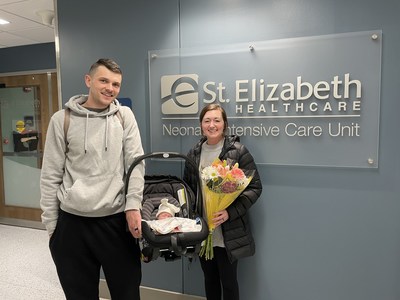Veronica and Sean Williams could not have imagined the events following a high heart rate alert from Veronica’s health watch. After mom-to-be and her partner notified their obstetrics care team via MyChart, it was recommended that they visit the Emergency Room (ER) for what they assumed would be a quick checkup. Little did they know, Sean would later be forced to answer the unimaginable question, “If we can only save one of them, mom or baby, who do you want us to save?”
After receiving an electrocardiogram (EKG) in the ER, Veronica found herself being prepared to undergo an emergency cesarean section in the unlikeliest of places: the Cardiac Catheterization Lab. Throughout the entire life-saving process, nearly 50 St. Elizabeth medical professionals squeezed into the Cath Lab and worked together as a unit, offering crucial interventions and support. As Veronica fought for her life, her heart completely stopping at times, more than six different St. Elizabeth teams acted swiftly to keep both mom and baby alive.
“When you hear the baby’s heart rate drop down to the 70s, the most important question is, ‘How are we going to get her out in the quickest and safest way?'” said Dr. Lisa Guyton, the delivering OB-GYN. “Thanks to Dr. Marleen Johnson, the emergency medicine physician working that day, the appropriate teams were notified and ready to provide any lifesaving measures necessary for mom and baby.”
Just three hours after Sean and Veronica’s arrival at the ER, baby Brooklynn was born.
“We’ve delivered babies in beds, toilets, cars and the Intensive Care Unit (ICU), but never would I have imagined delivering in the Cath Lab,” said Jocelyn Laake, Assistant Nurse Manager in the Family Birth Place.
St. Elizabeth nurses noted this was the first-ever Cath Lab delivery in St. Elizabeth history—and hopefully, the last.
Once baby Brooklynn was delivered safely and brought to the Level III Neonatal Intensive Care Unit (NICU) at St. Elizabeth, Veronica lay unresponsive, vital signs weak, awaiting transfer to a heart specialist at a neighboring hospital. Unsure if Veronica would ever have the chance to meet her baby, a touching decision was made by the St. Elizabeth teams. They would bring Brooklynn from the NICU to place her in her mother’s arms. What happened next left the team speechless and without a dry eye in the room: both Brooklynn’s and Veronica’s heart function and vital signs improved upon skin-to-skin touch.
“We wanted baby and mom to meet because we knew they may not have another opportunity; we truly didn’t know if mom was going to wake up. We knew it was the right thing to do,” said Keri Hinson, NICU Nurse Manager. “But we had no idea the vital signs would be impacted. It was an amazing experience that none of us will soon forget.”
While Veronica has little memory of the experience beyond what her partner and family have slowly shared with her, Sean will never forget the traumatic, life-changing event. At one point, he was told his wife only had a 25 percent chance of surviving. It was later determined that Veronica suffered from lymphocytic myocarditis, likely the result of a lingering cold.
“Never would you expect a C-section to be performed in the Cath Lab,” said Melissa Canter, Cardiac Cath Lab Manager. “But we were faced with the question of ‘Who do we save, mom or baby?’ and we refused to answer with anything other than: ‘Both.’ It was just amazing to watch the various teams — many of which had never met before — work together to save their lives. The room was lined with people waiting to jump in to do their part.”
The life-saving efforts from healthcare professionals reflected the multidisciplinary approach to care at St. Elizabeth, spanning across seven units including:
- Midwifery
- Emergency Room
- Cardiac Catheterization Lab
- Cardiac Intensive Care Unit
- Obstetrics and Gynecology
- Labor and Delivery
- Neonatal Intensive Care Unit
“Dr. George Christensen, and truly all of the St. Elizabeth associates involved were immaculate,” said Sean. “Their support was overwhelming—in a good way,” he recounted.
After overcoming what seemed to be an insurmountable medical emergency, the Williams family is home, safe and sound, recovering well. Brooklynn has already doubled her birth weight and mom is expected to make a rare, but full recovery in six months to a year, and will eventually return to work at St. Elizabeth where she supports human resources.
Veronica’s biggest takeaway?
“Pay attention to your symptoms and reach out to your doctor, and then listen to their advice,” she encouraged.
“It’s so important to trust your body and trust your doctors,” Sean added.
The St. Elizabeth physicians and associates involved in this incredible chain of events share the same advice and sentiment. “We’re just so grateful the midwife team encouraged Veronica to go to the ER,” said Dr. Guyton. “Had she delayed coming to the ER by even a few minutes, there could have been a very different result. It’s a crucial reminder to not ignore signs and symptoms and listen to the advice of medical experts.”
Remember to give yourself grace if you’ve been through traumatic experiences.
“There are days when it’s extremely difficult,” said Veronica. “But then I remind myself how happy I am to even be alive. I just take it one day at a time and appreciate every precious moment with my daughter and husband.”

